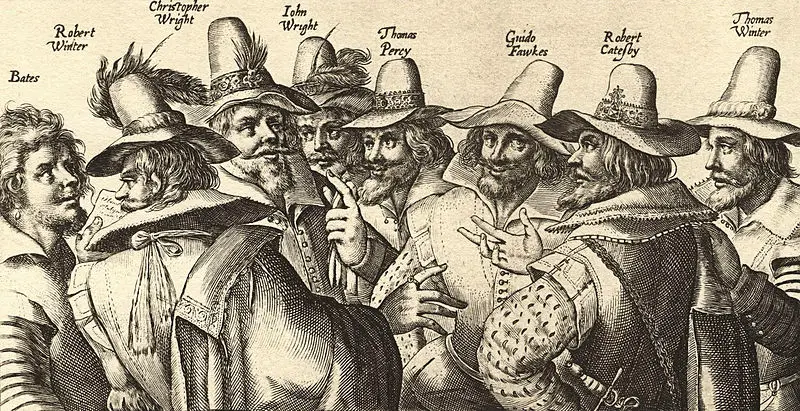In today’s vernacular, the word “guy” or “guys” can mean a male, a group of men, sometimes even a female, and a group of males or females, such as “those guys.” How did this come to be, and why and where did the term “guy” come from?
The origin of our use of the word “guy” started from an event that never succeeded but got pretty close. It all began over four hundred years ago in 1605 with a failed assassination plot by a group of thirteen English Catholics to destroy the British House of Lords and James I, the King of England. This assassination attempt became known as the Gunpowder Plot. This failed event ended up being used as a way to attempt to control non-conforming Catholics while also unifying the country.
Catholics had been repressed under Queen Elizabeth I, and that repression went even further when King James I took over the throne. He ordered that all Catholic priests had to leave the country and defined Catholicism as superstition in 1604. Even though Catholics had a belief that King James I would be different than his predecessor, it was not the case, and King James I was intolerant of the Catholic religion. As a result, a series of conspiracies had been attempted against both Queen Elizabeth I and King James I. None were successful, but the Gunpowder Plot in 1605 came very close.
One member of the conspirators was named Guy Fawkes. He later became associated as the face of the Gunpowder Plot, but he in fact was a late addition to the group of conspirators. In 1605, Guy Fawkes was using the first name of Guido instead of Guy. He worked as a caretaker of the cellar beneath the House of Lords and used the alias, John Johnson. Fawkes, along with 12 other conspirators, stored 36 barrels of gunpowder in the cellar, and he was the one tasked with setting off the explosives that would kill King James I and his oldest son as well as destroy the House of Lords and the House of Commons on the State Opening of Parliament. But an anonymous letter was given to a member of parliament on October 26, 1605, that told of the plot. The cellars were searched after midnight on November 5, 1605, and Fawkes was arrested next to the 36 barrels of gunpowder.
Fawkes was taken to the Tower of London, tortured, and later confessed. He then gave up the names of others involved in the conspiracy to blow up the House of Lords. He was hanged, drawn and quartered, and pieces of his body were sent to four corners of the country in January of 1606 as a warning that no one should try this sort of thing again. How then did the first name of Guy Fawkes come to mean what it does today?
The name of Guy Fawkes became associated with the plot, and November 5th was quickly enacted as a day to celebrate, even being called Guy Fawkes Day (or Night) and Bonfire Night. The celebrations became a national day filled with fireworks where effigies of prominent Catholics, the Pope, and Guy Fawkes were burned. The word “guy” then became associated with a derogatory term for a man, usually meaning that a man was bad. It also had the meaning of “someone with a bizarre appearance.”
The word “guy” eventually spread to the United States, where it presumably lost its original context because the word “guy” began to be used simply to refer to a man or person while not always having a negative connotation. It crossed back over to Britain at some point with this new American meaning.
Even Guy Fawkes’s reputation has changed over time. His name began by being associated with a conspiracy and terrorism, while today, it has taken on a different form. One example comes from the 2006 movie V for Vendetta. The character, V, uses a mask based on a caricature of Guy Fawkes. The mask that was used in V for Vendetta also became a symbol of the group Anonymous, and it’s been used by protesters worldwide as a symbol of protest and anonymity. That mask has come to be known as the Guy Fawkes mask.
There is still some debate whether a woman, or a group of women, should be referred to as a “guy” or “guys.” Either way, the term had a dubious beginning, and thankfully, doesn’t refer to the same thing today. It’s a sure bet there would be a few dirty looks if it were.
Sources: Business Insider, History, Washington Times, Boston Globe



